
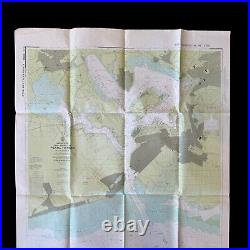
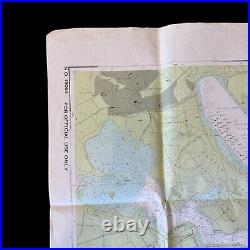
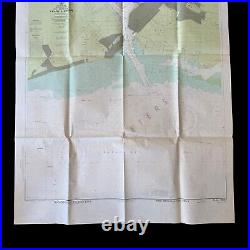
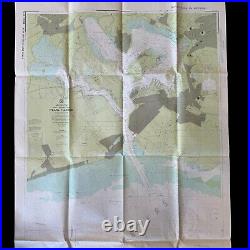
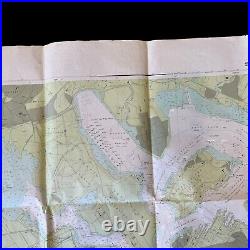
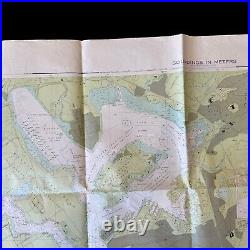
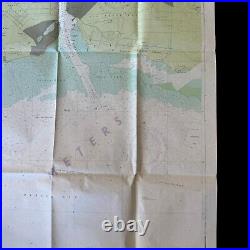
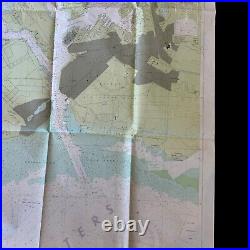
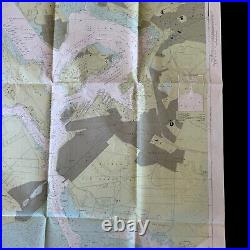
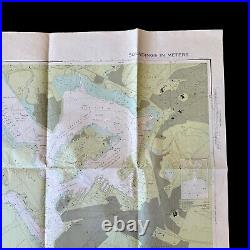
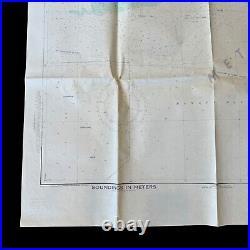

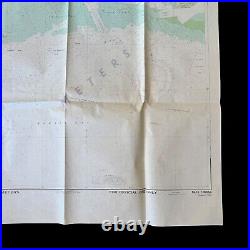
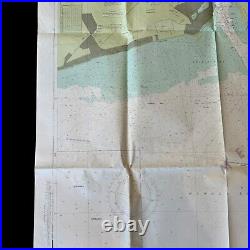
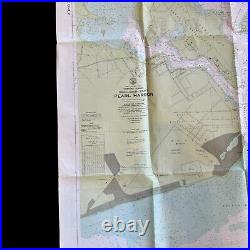
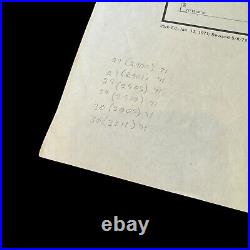

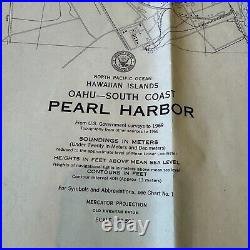
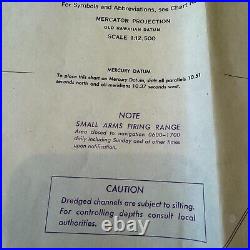
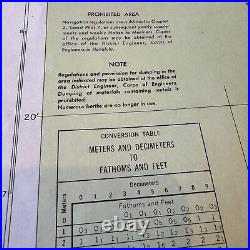
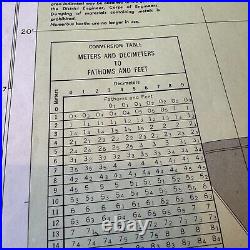
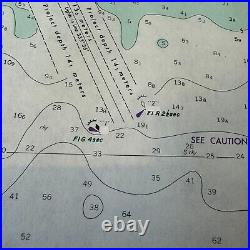
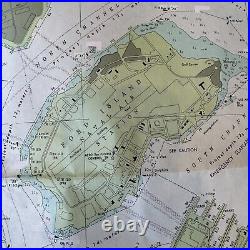

Comes with a hand-signed C. Size: 38 x 58 inches. This extremely rare and museum-grade artifact is an original 1972 U. Navy PEARL HARBOR – FORD ISLAND – OAHU SOUTH COAST Naval fathom depth chart. This is a one-of-a-kind USN chart was used by Navy vessels operating in the area of Pearl Harbor during the 1970’s. This fathom chart is used and features multiple hand-markings and calculations. Famously attacked on December 7, 1941, during World War II, it has since been a symbol of resilience and strategic military importance. By the 1970s, Pearl Harbor had evolved from its wartime destruction to become a critical hub for the United States Navy, playing a pivotal role during the Cold War era and beyond. Post-World War II Reconstruction and Cold War Context. Following World War II, Pearl Harbor underwent extensive reconstruction to repair the damage inflicted by the Japanese attack and to modernize the facilities to meet the demands of the Cold War era. By the 1970s, Pearl Harbor had become one of the most advanced naval bases in the world. The Cold War, characterized by the geopolitical tension between the United States and the Soviet Union, necessitated robust naval capabilities and strategic positioning. Pearl Harbor’s location in the Pacific made it an essential asset for the US Navy, providing a forward base of operations to project power and influence across the Asia-Pacific region. During the 1970s, Pearl Harbor’s strategic significance was underscored by its role in several key areas. Forward Deployment and Readiness : Pearl Harbor served as a critical forward deployment base, allowing the US Navy to maintain a state of readiness in the Pacific. This was particularly important during periods of heightened tensions, such as the Vietnam War and various Cold War confrontations. Fleet Operations and Support : The base supported a variety of fleet operations, including the maintenance and repair of naval vessels. Its facilities could accommodate everything from submarines to aircraft carriers, ensuring that the Pacific Fleet remained operational and effective. Training and Exercises : Pearl Harbor hosted numerous training exercises and war games, essential for maintaining the combat readiness of US naval forces. The base’s location allowed for realistic training scenarios in a range of maritime environments. Logistical Hub : As a logistical hub, Pearl Harbor facilitated the movement of supplies, personnel, and equipment across the Pacific. The base’s infrastructure supported the logistical demands of both routine operations and large-scale military deployments. Geopolitical and Diplomatic Roles. Beyond its military functions, Pearl Harbor also played a significant geopolitical and diplomatic role during the 1970s. The base served as a symbol of US commitment to its allies and partners in the Asia-Pacific region. Key aspects of its geopolitical significance included. Alliances and Partnerships : Pearl Harbor was a cornerstone of US alliances in the Pacific, including the US-Japan Security Alliance, the ANZUS Treaty with Australia and New Zealand, and other bilateral agreements. The base facilitated joint exercises, port visits, and cooperative security initiatives with allied navies. Deterrence : The presence of a powerful naval base at Pearl Harbor acted as a deterrent to potential adversaries, signaling US resolve to protect its interests and maintain stability in the region. This was particularly important during periods of heightened Cold War tensions. Regional Stability : Pearl Harbor’s capabilities allowed the US Navy to respond rapidly to regional crises, whether through humanitarian assistance, disaster response, or military intervention. The base’s strategic location enabled the US to project power and influence across the Pacific, contributing to regional stability. While Pearl Harbor was a critical asset for the US Navy in the 1970s, it also faced several challenges and adaptations. Environmental Concerns : The expansion and modernization of the base raised environmental concerns, including the impact on local ecosystems and marine life. The Navy implemented measures to mitigate these effects, balancing operational needs with environmental stewardship. Community Relations : The presence of a large military base on Oahu had significant social and economic impacts on the local community. The Navy worked to maintain positive relations with local residents, addressing concerns related to noise, traffic, and other issues. Technological Integration : As new technologies emerged, the base had to continuously adapt its facilities and operations. This required ongoing investment in infrastructure and training to ensure that Pearl Harbor remained at the cutting edge of naval warfare. In the 1970s, Pearl Harbor was a linchpin of US naval strategy in the Pacific, combining advanced technological capabilities with strategic positioning to support the United States’ Cold War objectives. The base’s evolution from a site of wartime destruction to a modern naval hub underscored its enduring importance to American military power and geopolitical influence. As a forward deployment base, logistical hub, and center for technological innovation, Pearl Harbor played a crucial role in maintaining the readiness and effectiveness of the US Navy during a critical period in global history.

